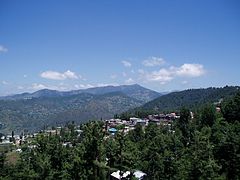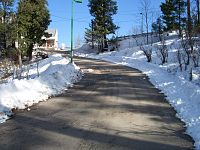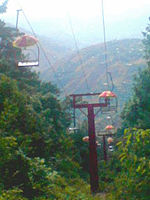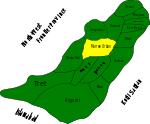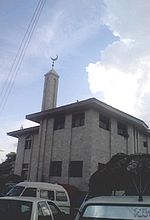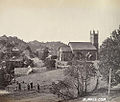- Murree
-
This article is about the city. For the beer and brewery, see Murree Brewery.
Murree
مریCoordinates: 33°54′15″N 73°23′25″E / 33.9042°N 73.3903°ECoordinates: 33°54′15″N 73°23′25″E / 33.9042°N 73.3903°E Country  Pakistan
PakistanProvince Punjab District Rawalpindi Government – administrator Umer Jahangir Elevation 2,291.2 m (7,517 ft) Time zone PST (UTC+5) Number of Union councils 1 Murree city (Punjabi, Urdu: مری) is a popular hill station and a summer resort, especially for the residents of Rawalpindi/Islamabad, and for the cities of the province of Punjab, Pakistan. Murree is also the administrative centre of Murree Tehsil, which is a sub-division of Rawalpindi District and includes the Murree Hills.
Murree is located along Islamabad-murree expressway highway , some 58.3 km (36.2 mi) northeast of Islamabad.
The name Murree is derived from 'marhi', "high place"[1] although there is a popular belief it is named after the virgin Mary.[2]
Description
Murree is one of the largest resort towns in the Galyat area of Pakistan, and is the capital city of Murree Tehsil (which is an administrative division of the Rawalpindi District). It is situated on the southern slopes of the Western Himalayan foothills as they ascend to the northeast towards Kashmir. During British Rule in the nineteenth century, its altitude was established at 7,500 feet (2,300 m).
Murree is accessible by road from the centre of the Islamabad and Rawalpindi areas. It is still associated with Britain; many British fruits (including cherries, raspberries and strawberries) thrive locally. There is a church, built in 1857, located at the centre of the town, which is still used as a place of worship. Many houses around the church are still standing, functioning mostly as hotels. Old traditional restaurants have been replaced by fast food shops and newer restaurants. Some old places of accommodation, such as the Rich Villa Inn and Gulberg Hotel, have completely disappeared. A typical hotel usually provides a motel type accommodation with breakfast and communication access. Newly built hotels are also accessible.
Murree has expanded since 1947 at a rate much greater than that which its infrastructure can sustain. Securing water and electricity has been a constant challenge. The jam-packed bazaar has caught fire a number of times in the last century, and the growth of tourism and a construction boom have had an adverse effect on the local environment.
History
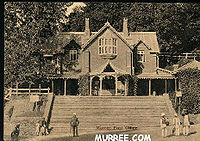 A 19th century post office
A 19th century post office
Murree was founded in 1851 by the Governor of Punjab, Sir Henry Lawrence, and was originally established for the British troops garrisoned on the Afghan frontier[3] as a sanatorium.[4]
The permanent town of Murree was constructed at Sunnybank in 1853. The church was sanctified in May 1857, and the main road, Jinnah Road, formerly known as The Mall (and still commonly referred to as), was built. The most significant commercial establishments, the Post Office, general merchants with European goods, tailors and a millinery, were established opposite the church. Until 1947, access to Jinnah Road was restricted for "natives" (non-Europeans).
Until 1876, Murree was the summer headquarters of the Punjab local government; after 1876 the headquarters were moved to Simla.[4]
The railway connection with Lahore, the capital of the Punjab Province, made Murree a popular resort for Punjab officials, and the villas and other houses erected for the accommodation of English families gave it a European aspect. It was described in the Gazetteer of Rawalpindi District, 1893–94 as follows:
The sanatorium of Murree lied in north latitude 33° 54′ 30″ and east longitude 73° 26′ 30″, at an elevation of 7,517 feet (2,291 m) above sea level, and contained a standing population of 1,768 inhabitants, which was, however, enormously increased during the [May–November] season by the influx of visitors and their attendant servants and shopkeepers. It is the most accessible hill station in the Punjab, being distant from Rawalpindi only a five hours' journey by tonga dak. Magnificent views are to be obtained in the spring and autumn of the snow crowned mountains of Kashmir; and gorgeous sunset and cloud effects seen daily during the rains [July–August]. Part of the station, especially the Kashmir end, are also well wooded and pretty.[3]
In 1901 the population of the town was officially 1844, although if summer visitors had been included this could have been as high as 10,000.[4]
In the hot season it was the headquarters of the Lieutenant General of the Northern Command. The Commissioner of the Rawalpindi Division and the Deputy-Commissioner of Rawalpindi also resided here during part of the hot season, for which period an Assistant Commissioner was placed in charge of the subdivision consisting of Murree Tehsil. The site was selected in 1850 almost immediately after the annexation of the Province, and building operations commenced at once. In 1851 temporary accommodation was provided for a detachment of troops; and in 1853 permanent barracks were erected. The garrison generally consisted of three mountain batteries. In 1873, 1874, and 1875 Murree was the summer headquarters of the Punjab Government. It was connected with Rawalpindi town by a service of tongas.[5]
The houses crown the summit and sides of an irregular ridge, commanding magnificent views over forest-clad hill-sides into deep valleys studded with villages and cultivated fields. The neighbouring hills were covered during the summer with encampments of British troops, while the station itself is filled with European visitors from the plains and travellers to Kashmir. A fine view of the snowy peaks of Kashmir is to be had on a clear day, and the crest of Nanga Parbat (26,182 feet (7,980 m)) can sometimes be seen. The municipality was created in 1850.[5]
The income during the ten years ending 1902–3 averaged Rs. 49,500, and the expenditure Rs. 48,200. In 1903–4 the income and expenditure were Rs. 5r,400, chiefly from octroi, and Rs. 54,400 respectively. The income and expenditure of cantonment funds averaged Rs. 10,000 between 1893 and 1903. The chief educational institutions are the Lawrence Military Asylum for soldiers' children, and the St. Denys' and Convent English schools for girls. The station contains the Lady Roberts Home for invalid officers and a branch of the Alliance Bank of Simla. The Murree Brewery was the only industrial concern of any importance.[5]
Buildings and Tourist Attractions
Murree houses headquarters of 12th infantry division of Pakistan Army and large number of educational and training institutions. Combined Military Hospital established to cater the needs of civilian population of Murree and adjoining areas. Pakistan Air Force also maintains base at Lower Topa. For administrative purposes the military areas of Murree are divided in two separate cantonments, Murree Cantonment and Murree Hills Cantonment.
Murree Houses residence for Punjab Governor at the Kashmir point. The imposing building was built in nineteenth century by the British. There are Punjab and Sindh Houses to cater needs of the provincial government. Similarly, there are Rest Houses for the Judges of Supreme Court and Lahore High Court. A large number of government, semi government and private departments and institutions maintain guest houses in Murree. A number of diplomatic missions based in Islamabad established their camp offices in Murree in the 1960s. The same however are seldom used now. Adjacent to Murree is the Galliat region of North West Frontier Province which includes Nathiagalli, Ayubia, Khanspur, Dunga Galli, Khairagalli and Changla Galli. Before the British rule whether part of Rawalpindi District of Muzaffarabad, Murree and Galiat have been part of same administrative unit, however in 1850 the British decided to divide them between Rawalpindi and Hazara. Howevere despite divided by provincial boundaries, Murree and Galliat are inseparable both geographically, culturally, linguistically as well as from the point of view of the tourists. Murree serves as a gateway to Galliat.
In recent years Bhurban and New Murree (Patriata), have also developed as a tourist centre. The whole Murree Galliat region is known throughout South Asia for its scenic beauty and fascinating greenery. Mountains overhung with pines and oaks, bubbling with gurgling springs, crisscrossed by rivulets, dotted with sprawling lawns and orchards overloaded with fruits present spectacle of Paradise on earth. Bhurban, boosting with five star Pearl Continental Hotel owned by Pakistan's best hotel chain and a nine hole Golf course has cropped recently as another tourist attraction in Murree area. Pearl Continental Hotel is the only 5 Star hotel in whole Murree Region. Lying at an altitude of 6000 ft, Bhurban is situated at a distance of 13 kilometers from Murree on one of main roads leading to Azad Kashmir. Punjab government is planning to develop New Murree city at Patriata fifteen kilometers southeast of Murree. Punjab Tourism department constructed resorts at the virgin forests on the Patriata ridge in 1987 besides a 3 kilometer sky ride from Gulara Gali to the top of Patriata ridge. Patriata is connected with Islamabad and Murree through a number of all weather roads.
1857 War of Independence
See also: 1857 War of Independence in MurreeIn the summer of 1857, the local tribes of Murree and Hazara, including the Dhond Abbasi and Tanoli, planned to attack the British Army. The campaign was led by Sardar Sherbaz Khan of Dhond Abbasi tribe, and by Malik Nawab Bahadur Khan of the Tanoli tribe. They fought respectably against the British Army, giving the British considerable difficulties. The British Army eventually signed an agreement with the local Abbasi tribe, which was refused by the Tanoli tribe, thereby dividing the opposition to the British. The British Army later ignored the agreement to take control of Murree again.[6]
British presence
After the British forces' occupation of Murree and Abbottabad, many English soldiers and administrators opted to spend the summers there because of the cooler climate. The British settled in and raised families. Some prominent people who were born here include:
- Bruce Bairnsfather - a famous cartoonist during world War I
- Francis Younghusband - an army officer and explorer. He established the Bible Society in the Christian High School in Geryal Murree. The society did in depth research into the local languages. This society translated a chapter of new testament book Loqas in Dhondi that was noted by the compilers of the "Linguistic Survey Of India".[7]
- Reginald Dyer - officer responsible for the Amritsar Massacre
- Berta Ruck - was a romantic novelist, writing almost eighty novels over the course of her writing career.
Climate
Murree Climate chart (explanation) J F M A M J J A S O N D 127701458117712413317992221313025163402216326211514721137019103315670102Average max. and min. temperatures in °C Precipitation totals in mm Source: World Weather Information Service Imperial conversion J F M A M J J A S O N D 545325.74633753405.263483.671555.177611372601371605.870562.865501.358432.85036Average max. and min. temperatures in °F Precipitation totals in inches Murree features a subtropical highland climate (Cwb) under the Köppen climate classification. It is situated in the outer Himalayas, retaining high altitude. This type of area has cold, snowy winters, relatively cool summer with drastically escalated rain, in relation with lower altitudes, and frequent fog. Precipitation is received year round, with two maximas, first one during winter and second one at summer, July–August.[8] Total mean precipitation annually is 1,789 mm (70.4 in).[9]
Animals
Many rare animals can be found in Murree. One example is the leopard, which inhabits the neighboring Galiyat region. More common animals include the Rhesus Monkey, foxes and various species of pheasant including the chir and kalij.
Tribes
The main tribe of Murree are the Dhond Abbasi. Other tribes are the Syeds, Khawajas, Kethwal Rajputs, the Dhanyals, Awans, Jasgam, Satti, Baig, Janjua Rajpoot (mainly populated on eastern side of Murree) Qureshi Family, mirza, Mengiral Rajput Jats, Kashmiri, Balti, Afghani and Barlas.
Administration
As well as being tehsil headquarters, Murree is also a Union council, it is bounded to the north by Darya Gali and Rawat, to the west by Ghora Gali, to the south by Numbal and Mussiari, and to the east by Ghel and Charhan.
Police
Murree Police is headed by a Police Officer of the rank of Assistant Superintendent of Police. It consists of one Police station and nine police posts.
Education and Literacy
Murree has been known for its elitist educational institutions which have been attracting students from across the country since independence. Lawrence College Gora Gali, established as Lawrence Memorial Asylum in 1860 for children of serving or retired British soldiers away from tropical climate of sub-continent. It was part of chain of four such schools established across British India. Spread over an area of more then 150 acres at an altitude of 6397 feet (1950 meters) Lawrence College provides education from class one to twelve including A level and O level and is popular among Pakistani upper classes. Other colleges established during the British period for the children of British colonialist but now serving the Pakistani gentry include Saint Dynes and Convent of Jesus and Marry. Saint Dynese has recently closed it boarding to in order to cater the needs of local population. Other schools established after independence include Cadet College Lower Topa, Cadet College Murree Pindi Point, Army Public School.
Religion in Murree
Islam is the mainly followed religion. However, there is also a significant Christian presence; churches from the British Era can be found in various parts of Murree.
Journalism in Murree
The earliest records of newspapers being sold in the Murree Hills are from 1936 during British rule.
New Murree Project
The government of Punjab is at the brim of initiating the "New Murree Project" to promote tourism.[10] The location selected for this project is Patriata after considering the other three, Ban, Barian and Charihan. This project will cover 4,111 acres (16.64 km2) of land, including 3,849 acres (15.58 km2) of the Murree Forest Division and 262 acres (1.06 km2) of the Rawalpindi North Forest Division.[10] The water for Murree City will be supplied from River Jhelum.
Journalism in Murree hills
Salim Shiwalvi Sahib , Imtiz ul Haq and Abdul Manan Farooqui ( commonly known as A M Faroqui ) are Pioneer in journalism in Murree hill. Other new names in this filed are very famous Kashif Abbasi Javid Sadsadque Ansar Abbasi but Imtiz ul Haq was oldest as reporter and youngest as person to work for news paper, he worked all his life as committed journalist, because of that he is life time member & president of Murree hill press club.An other name in Murree Journalism is Raja Abdul Rahman Janjua who has contributed number of exclusive stories to news papers who is now practicing as an advocate in the courts at Murree, Rawalpindi.Raja Abdul Rahman is presently representing the most famous English daily news paper of Pakistan daily namely " The News".( a famous news paper of Jang-group of newspapers).
Picture gallery
Localities & Union Councils
- Rawalpindi District
- Circle Bakote
- Mukeshpuri
- Abbottabad
- Ayubia
- Bhurban
- Birote
- Ausia
- Changla Gali
- Dunga Gali
- Gulehra Gali
- Ghora Gali
- Bansra Gali
- Jhika Gali
- Khaira Gali
- Mohra Sharif
- Nathia Gali
- Sehr Bagla
- Patriata
- Thandiani
- Karore
- Phagwari
- Las Kothar
References
- ^ "Murree" Concise Dictionary of World Place-Names. John Everett-Heath. Oxford University Press 2005. Oxford Reference Online. Oxford University Press. Accessed 14 June 2008 <http://www.oxfordreference.com/views/ENTRY.html?subview=Main&entry=t209.e5014>
- ^ Mystery of the Tomb of Mary - Dawn Magazine
- ^ a b Murree, in the Punjaub, 1863
- ^ a b c Murree - Encyclopædia Britannica Eleventh Edition
- ^ a b c Murree Town - Imperial Gazetteer of India, v. 18, p. 43
- ^ A view from Pakistan
- ^ This has now been republished as the "Linguistic survey of Pakistan, vol V" by sang-e-Mil publishers Lahore
- ^ Nazaria-i-Pakistan Trust. "Pakistan Essentials - Climate and Weather". http://nazariapak.info/pak-essentials/climate.asp. Retrieved 2009-07-01.
- ^ World Weather Information Service - Murree
- ^ a b New Murree project in harmony with environment - Daily Times Pakistan
External links
Capital MurreeUnion councils Angoori • Ban • Charhan • Darya Gali • Dewal • Ghel • Ghora Gali • Mussiari • Murree • Numbal • Phagwari • Potha Sharif • Rawat • Sehr Bagla • TretMajor cities in Pakistan Islamabad Capital Territory Punjab Attock · Bahawalpur · Chakwal · Chiniot · Faisalabad · Gujar Khan · Gujranwala · Gujrat · Jhang · Jhelum · Kasur · Kharian · Lahore** · Mianwali · Multan · Murree · Rahim Yar Khan · Rawalpindi · Sadiqabad · Sahiwal · Sargodha · Sheikhupura · Sialkot · TaxilaSindh Khyber Pakhtunkhwa Balochistan Azad Kashmir Gilgit-Baltistan *Federal capital **Provincial/Territorial capitalsCategories:- Hill stations in Pakistan
- Populated places in Rawalpindi District
- Populated places established in 1851
- Places of Indian Rebellion of 1857
- Galyat of Pakistan
- Resorts in Pakistan
Wikimedia Foundation. 2010.

